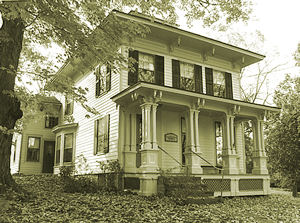Native Americans probably began migrating through the area as long ago as 10,000 years, and many camped here for short periods of time over the years, but the first sustained settlements were the large Seneca villages of the late 1500’s through the 1600’s. Since the Seneca abandoned and rebuilt their palisaded villages about every 15-20 years, they occupied a series of villages within present day Lima, each occupied by about 800 to 1000 people living in multifamily longhouses. Contact with Europeans traders and missionaries during this period precipitated significant changes in the traditional Seneca way of life.
Lima’s first non-native settlers came in 1788 — Revolutionary War veterans who were attracted by the excellence of the town’s soils and agricultural potential. The town grew rapidly throughout the first half of the 19th century, with the downtown village core becoming a thriving commercial center that supplied a diverse array of goods and services to an expanding population settling the surrounding countryside.
During this time, Lima’s prosperous and public-spirited farmers and merchants built many fine commercial, residential, educational, and public buildings in the village, and were able to attract two prestigious academic institutions to the community — Genesee Wesleyan Seminary and Genesee College. Located at the intersection of the old State Road (Routes 5&20), and Route 15A, a main North/South crossroad, 19th century Lima became widely known as a vibrant and successful agricultural, commercial, and academic center—”the Crossroads of Western New York.”
During the mid to late 20th century, shifting patterns of highway usage, demography, occupation, and retail business altered the social and economic “landscape” in Lima. However, despite the transitions, most of the 19th century commercial structures in the downtown core, and historic homes throughout the village and town, retained their original architectural character (59 Lima structures listed on the State and National Registers of Historic Places). Now with the renewed interest in small towns, walkable communities and an excellent school system, Lima is experiencing increased pride in its historic character. The many new businesses downtown and increasing home values are a testament to this revitalization.




